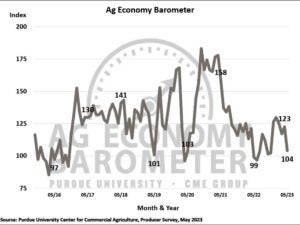Bank failures, rising interest rates, lower crop prices, and other factors appear to be negatively affecting farmer sentiment.
Producer sentiment fell to its weakest reading since July 2022, as the Purdue University/CME Group Ag Economy Barometer declined 19 points to 104 in May. This leaves the index five points above where it was last year but 54 points below where it was two years ago.
The Ag Economy Barometer is calculated each month from 400 U.S. agricultural producers’ responses to a telephone survey. This month’s survey was conducted between May 15 and 19.

Meanwhile, farmers appear to be struggling with expectations for the future, likely because of weakened crop prices. The Index of Future Expectations dropped 22 points to a reading of 98 in May, while the Index of Current Conditions was also down 13 points to a reading of 116.
Crop prices in mid-May dropped for corn, soybeans, and wheat compared to mid-April bids. Eastern Corn Belt fall delivery bids for corn fell over $0.50 per bushel, and soybean bids declined over $1.00 per bushel, while new crop June/July delivery wheat bids declined nearly $0.50 per bushel.
Producers are feeling the squeeze from weakened crop prices, which has reduced their expectations for strong financial performance in the coming year.
The Farm Financial Performance Index reflected this month’s weak sentiment reading, dropping 17 points to a reading of 76 in May.
Crop price weakness, uncertainty related to U.S. bank failures, and rising interest rates were likely key factors behind the decline. This month, 38 percent of respondents said they expect weaker financial performance for their farm this year, compared to just 23 percent who felt that way in April.
Higher input cost remains the top concern among producers in the year ahead; however, concern over the risk of lower crop and livestock prices is growing. This month, 26 percent of respondents chose lower output prices as their top concern compared with just 8 percent of respondents who felt that way in September. Meanwhile, nearly three-fifths of producers said they expect interest rates to rise during the upcoming year, and 22 percent of respondents chose it as a top concern for their farm in the next 12 months. Additionally, 40 percent of farmers in this month’s poll said they expect this spring’s U.S. bank failures to lead to changes in farm loan terms in the upcoming year, possibly putting more financial pressure on their operations.
Unsurprisingly, the Farm Capital Investment Index was also lower, down six points to a reading of 37 in May. More than three-fourths of respondents continue to feel now is the wrong time for significant investments. Among those who think now is a lousy time, two-thirds cited rising interest rates and increased machinery and new construction prices as key reasons.
Producers’ expectations for short-term farmland values fell 13 points to 110 in May, marking the weakest short-term index reading since August 2020. In this month’s survey, just 29 percent of respondents said they expect farmland values to rise over the next 12 months compared to 54 percent who felt that way a year earlier. In contrast, producers remain more optimistic about the longer-term outlook for farmland values as the Long-Term Farmland Value Expectations Index rose 3 points in May to a reading of 145.
With farm bill discussions ongoing, this month’s survey asked respondents what title in the upcoming legislation will be most important to their farming operation. Nearly half of the producers surveyed said the Crop Insurance Title would be the most important aspect of a new farm bill to their farms, followed by the Commodity Title, chosen by 25 percent of respondents.
In a follow-up question, corn and soybean growers were asked what change they expect to see to the Price Loss Coverage reference prices in a new farm bill. Nearly half of corn and soybean growers said they expect Congress to establish higher reference prices for both crops, with very few expecting lower reference prices for soybeans and corn, respectively.
»Related: Kansas wheat yields to fall short following prolonged drought


